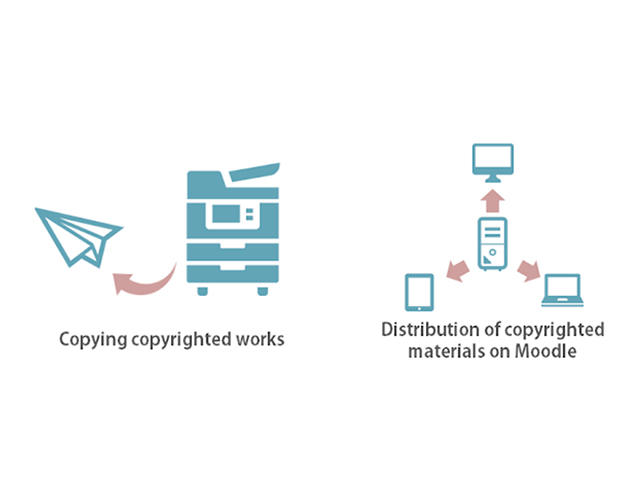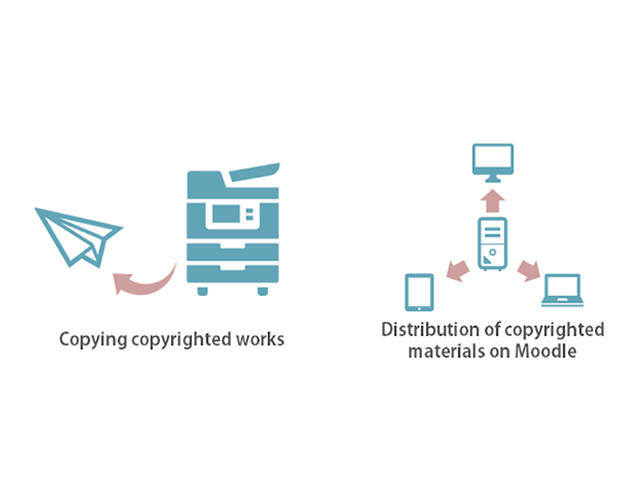Amendment of the Copyright Act: Course materials in online classes
- Amendment of the Copyright Act: Course materials in online classes
- Useful links about copyright and copyright free materials
Effectuation of the “Compensation System for Public Transmission for Educational Purposes” under the Copyright Act amended in 2018
What has changed?
As a result of the 2018 amendment of the Copyright Act, it has become possible for each educational institution to publicly transmit a work without obtaining the authorization of the copyright owner by paying compensation, when the exploitation of the work is within a certain scope. (For example, printing/photocopying and distributing a work in face-to-face classes had already been possible under Article 35 of the Copyright Act, but uploading a PDF of the work to a server such as Moodle had previously not been possible.)
"The Compensation System for Public Transmission for Educational Purposes" came into effect ahead of schedule on April 28, 2020, to respond to the need for remote classes, etc. arising due to COVID-19. Participation in this scheme was free for FY 2020; from FY 2021, payment has become necessary. ICU has joined this scheme.
It has been permissible to transmit a work, etc. made available in fae-to-face classes simultaneously to the public for class purposes. The scope of this will be broadened, and it will become possible, among other things, to transmit a work, etc. in so-called synchronous distance learning classes transmitted from studio-type settings and asynchronous distance learning classes as well as for preparation and revcision.
It had already been permissible to conduct simultaneous public transmission of face-to-face classes for educational purposes. The scope of this has been broadened, and it has become possible, among other things, to transmit a work, etc. in so-called studio-type synchronous remote classes and asynchronous remote classes as well as for preparation and review. However, the provisions allow this only for persons in charge of teaching and persons taking classes at schools or other educational institutions, and only to the extent that is found to be necessary in the course of classes. When exploiting a work in a way that would unreasonably prejudice the interests of the copyright owner, authorization from the copyright owner on an individual basis is required as before.
- Definition of “classes” (p.6 (4) )
- Definition of “the extent that is found to be necessary” (p.7 (7))
Below is a list of things that could not be done previously but have become possible as a result of the amendment.
- Showing a portion of a book or a newspaper article on the screen in the online streaming of classes
- Uploading a PDF of a portion of a book or a newspaper article to a server (e.g., Moodle)
(Please read: Requests received from publishers) - Uploading unprotected music or audio to a server
- Uploading PPT files containing images for which authorization from the copyright owner has not been obtained to a server
(Example) Use in public transmission by educational institutions free of charge (JASRAC) https://www.jasrac.or.jp/news/20/200428.html
However, be mindful of the scope of Article 35 of the Copyright Act.
- The above does not apply “if the action would unreasonably prejudice the interests of the copyright owner”.
- Only the portion and the number of copies necessary for classes may be exploited. (The number of copies made must not exceed the number of enrollees.)
- Definition of “the extent that is found to be necessary” (Operational Guideline for Article 35 of the Amended Copyright Act [Fiscal Year 2021 Edition], p. 7 ⑦)
Below is a list of things that are not allowed in the first place.
- Photocopying or creating a PDF of an entire book or textbook and distributing the copies/PDFs
- Uploading a PDF of a chapter of a work for each class session and as a result uploading almost all chapters of the work
- Distributing a greater number of copies or PDFs than is necessary for classes
Below is a list of things that are being examined. (This does not mean that they have become possible.)
- Cases where an electronic journal, an electronic book, a database, or content distribution for which one has a personal subscription is used in a class. (There are cases where exploitation is restricted by a contract irrespective of the Copyright Act.)
- A copy- or access-limited work such as movies on Blu-ray Discs, DVDs, etc.
What does the phrase “if the action would unreasonably prejudice the interests of the copyright owner” mean?
“If the action would unreasonably prejudice the interests of the copyright owner”, the provisions of Article 35 of the Copyright Act are not applied and the compensation system is not applied, so authorization would be necessary.
- Materials such as workbooks or drill books that are sold with the assumption that they will be purchased
- Consider “whether the action of reproduction or public transmission may reduce the sales of a marketed material or obstruct potential sales channel[s] of the work in the future”(https://forum.sartras.or.jp/info/005/).
- The general rule is that only a small portion of a work may be exploited. (Note: For a guide on what amount is a small portion, see the definition of “the extent that is found to be necessary” (Operational Guideline for Article 35 of the Amended Copyright Act [Fiscal Year 2021 Edition], p. 7 ⑦).
Examples where it is highly likely that the interests of the copyright owner would be unreasonably prejudiced
- Distributing to an entire year group, to an entire department, or to all enrollees, etc. at a matriculation ceremony, etc.
- Reproducing or publicly transmitting copies where the number of copies made exceeds the total number of instructors, etc. teaching the class and enrollees, etc. in the class in cases where, among others, the same instructor, etc. teaches the same content in multiple classes, or several classrooms are set for the transmitter side and the receiver side in interactive classes
- The amount used in a class becoming more than a small portion of a work as a result of the same instructor, etc. exploiting a different portion of the same work in each class session
- Performing reproduction or public transmission of a work published in a material such as: a textbook, normally purchased by an instructor, etc. or a student, etc., entering a provision contract or being lent for the class purposes; or a material such as an exercise book (including one an instructor, etc. has instructed a student, etc. to purchase) in which each of the students directly writes an answer for exercise purposes, in a manner where the reproduction or public transmission will substitute for purchase of the material in which such a work is published.
- Making available a work of art, photograph, sheet music, etc. in a quality or manner that would influence the sales of a marketed commodity; in addition, taking and exploiting many such works from a single publication
- Binding a copy of a work and distributing the resulting copies
- Systematically stocking a work as materials onto a server (compiling a database)
*(Source: Operational Guideline for Article 35 of the Amended Copyright Act)
Finding information on copyright
We prepared a list of official websites of organizations constituting SARTRAS. The list contains links to official websites and contact details for obtaining authorization and making inquiries. Please feel free to make use of this list.
●A list of official websites of organizations constituting SARTRAS (internal access only)
Course materials that can be used in online classes
Resources and methods such as the following can be used without worrying about copyright.
- Posting links to a material instead of uploading them to a server (e.g., creating a direct link to a paper contained in a database that can be accessed)
- E-books, etc. licensed by the library
Off Campus Access https://login.othmer1.icu.ac.jp:2443/menu - Using Creative Commons licenses, Open Educational Resources, etc. https://docs.google.com/document/d/1EWyYhbvz7vGSoOoyWpSyngHJa-eIe6KwDa0eFmqp4I0/edit
- Using a portion of a source as a quotation (Article 32 of the Copyright Act)
FAQ
Q.May I upload course material or videos of classes on websites that anyone can see?
A. Course material and videos should only be made available to students enrolled in your course, so they should not be uploaded to websites that anyone can see. Uploading them to Moodle is fine as long as you limit access to students enrolled in your course. If you are using YouTube, select “Private” and share videos with your students.
Q. How about foreign works or works produced by persons not belonging to rights holders’ organizations such as JASRAC?
A. Foreign works or works produced by persons not belonging to rights holders’ organizations such as JASRAC can also be used if certain requirements are met.



